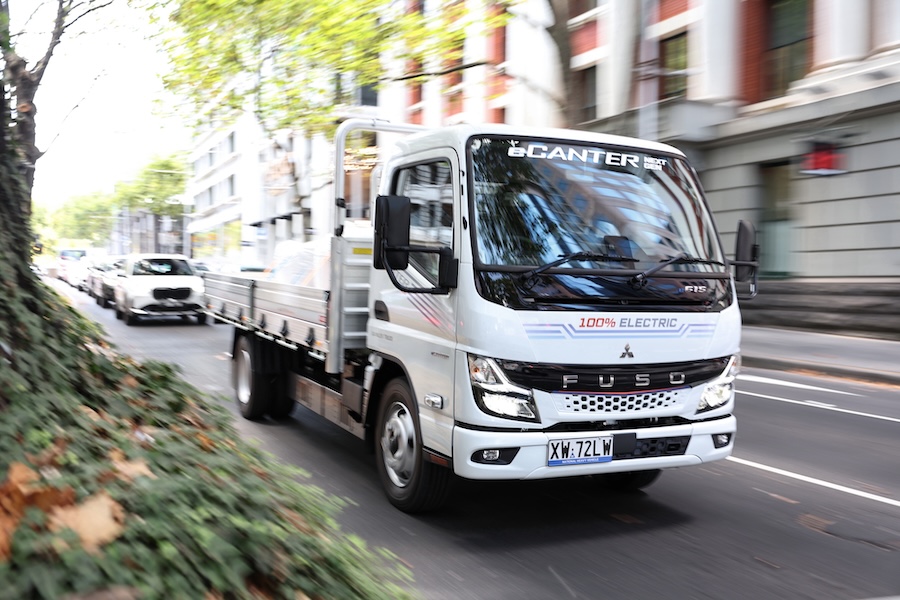Carbon neutrality and the subsequent zero emissions strategies being pursued in every sector of the automotive world are not passing fads. They are an ever more evident fact of modern life and right now, the latest generation of Fuso’s light-duty eCanter is possibly the most viable and practical truck of any type contesting Australia’s battery electric market
It may sound simplistic, but there are probably three distinct reasons why Fuso’s latest eCanter range sits at the top of the pole in the electric truck stakes.
First is the indisputable fact that as the newest descendant of the historically successful Canter family, it is designed and built for the metro and suburban workloads for which all light-duty trucks are primarily designed and built.
Second, it is exactly these traffic-dense roles where battery electric trucks are sure to achieve their greatest efficiency and influence both now and in the immediate future. Indeed, these are the local delivery tasks which more than any other will crash through the ice (internal combustion engine) barrier for battery electric trucks.
Third, and most notably, this new generation of eCanters sets a benchmark in driver appointments, safety systems and technical ascendancy which currently has no light-duty equal and will, in fact, require emerging competitors in the little truck league to bring something special to the electric truck table if they plan to compete on a remotely equal footing.
True, the light-duty sector is notoriously price conscious and likewise, electric trucks don’t come cheap compared to their diesel counterparts, especially if there’s the need for a fast charging system. What’s more, many prospective eCanter buyers are likely to be tradespeople or small manufacturing and retail businesses rather than dedicated operators of a trucking enterprise.
The thing is though, diesel prices are nowadays wildly erratic and almost always climbing, causing increased cost pressures on businesses of every type. Logically, the thought of putting no fuel at all in a truck as well as dramatically reduced maintenance costs, mixed with growing social awareness of emissions outputs in urban environments particularly, are clear attractions for any owner of any type of commercial vehicle.
Again though, if purchase price is too prohibitive, even these attractions risk losing their lustre. In medium and heavy-duty sectors, for instance, it’s common for electric truck models to be as much as 2.5 times more than a diesel equivalent. Sure, the price is likely to come down as demand and volumes increase but for the small truck owner plodding around town, it’s likely a price multiple too big to bear.
However, during a pre-drive meeting with Daimler Truck Australia’s vice-president of sales and marketing, Andrew Assimo, it was apparent the highly advanced and superbly equipped eCanter will be at least competitive with current and upcoming rivals. The whisper from within is that eCanter will be around 1.5 times the price of a diesel counterpart.
Responsible for all three brands in the Daimler Truck fold – Freightliner, Fuso and Mercedes-Benz – a typically cautious Assimo would not be drawn on specific cost structures for eCanter but insisted, “We will be competitive.” Moreover, the need for a pin-sharp price pencil becomes even more acute when it’s considered that Daimler Truck fully expects the highly ambitious Chinese brand Foton to be eCanter’s most aggressive competitor. In fact, according to recent reports, Foton aims to deliver around 1500 electric trucks through 2025.
Even so, Daimler Truck’s top brass are quick to emphasise Fuso’s considerable technical advantages, not least the inclusion of an e-axle which integrates a liquid-cooled motor and reduction gearbox, thereby deleting the need for a conventional gearbox and driveshaft to further enhance efficiency and tare weight. This feature alone puts eCanter in a class of its own but so too, perhaps, does the presence of an eight-year warranty on batteries and a full environmental program at the end of their first life.
Meantime, Andrew Assimo and Daimler Truck Australia president and chief executive officer Daniel Whitehead are convinced the timing for the launch of this new generation eCanter is ideal. Following the recent introduction of the supremely impressive Mercedes-Benz eActros 300 medium-duty model, they report “very high” demand for last-mile electric delivery trucks, citing eCanter’s model range of 14 variants and technical leadership as boons to hastening the transition to electric trucks in city and suburban areas.
Critically and predictably, this latest generation of eCanter also sticks rigidly to Daimler’s inherent safety doctrine with a full suite of electronic safeguards that include advanced front and side radar systems warning of pedestrians and other vehicles including cyclists. Wisely, particularly given the almost silent movement of an electric truck, an Acoustic Vehicle Alert System, or AVAS in Daimler parlance, is part of the standard package. The principal purpose, obviously enough, is to provide an audible warning to other road users and pedestrians when the truck is on the move at speeds up to 20km/h.
“We’ve taken the decision to make an audible warning standard despite no mandatory rule. To us, it’s a necessary safety feature,” Andrew Assimo confirmed. Again, a wise move.
Pushing progress
With this latest generation arriving from Fuso’s production plant in Japan and slated to go on sale here in May, eCanter needs little introduction. Much of the world took note when Daimler Truck launched the first evolution globally in 2017, arriving in our part of the world four years later as the first production electric truck to hit the Australian market.
There have, of course, been plenty of detractors about electric trucks in general since eCanter’s creation but attitudes are changing fast and without putting too fine a point on it, Fuso has been at the forefront of the push to carbon neutrality for metro applications more than any other. That push is now stronger than ever as technology and experience have combined to produce a new generation of light truck which is not only clean and green, backed by a world leader in battery electric development, but supremely smooth and easy for the driver, and brilliantly adept in the urban conditions it is so obviously designed for.
For its first promotional salvo with the latest and undoubtedly greatest eCanter, Daimler Truck offered two e615 models, one wide cab version and the narrower City Cab variant, hauling payloads – including aluminium tray bodies – of 2.5 tonnes or thereabouts.
From the outset it was apparent that eCanter has undergone a worthwhile refit. As the company blurb explains, there’s a ‘new-look interior with electric handbrake, high-resolution 10-inch driver display screen (and) Isri driver’s seat.’ Strangely though, only the wide cab model gets a driver’s suspension seat.
On the outside, a refreshed exterior design features LED headlights, tail-lights and daytime running lamps.
What’s more, both e615 models sport independent front suspension and rack and pinion steering.
Built on a 3400mm wheelbase, each version is rated to a gross vehicle mass of six tonnes but most significantly, they operate on two battery packs with a combined 83kWh capacity for a projected operating range of 200km. Larger models run three batteries for a range up to 300km but as our day in Melbourne’s traffic soon demonstrated, the 200km range of the e615 appears a conservative estimate.
For example, after almost 60km hauling a gross weight of 5.16 tonnes around the city and inner ‘burbs, the range indicator on the dash of the wide cab model showed there were still 150km of range remaining. The figures were much the same for the City Cab version despite a higher gross weight of almost 5.5 tonnes. In short, battery technology has indeed come a long way and gratefully, the range anxiety which was once part and parcel of early eCanter models isn’t nearly the issue it was.
So, too, have battery life and safety been dramatically enhanced. As Daimler states, ‘Two lithium ion phosphate battery packs … are thermally controlled with a class-leading in-battery liquid thermal control system to ensure the batteries operate at the most efficient temperature in all conditions. Some rivals,’ the company adds in an obvious swipe at some competitors, ‘have no thermal control for batteries or use a far more basic exterior cooling system.’
However, one thing that has never been an issue with battery electric trucks is performance and with 110kW of power and 430Nm of torque on tap, the latest eCanter is nothing short of stunning off the mark and responsive in all conditions. A warning though, just as a diesel truck’s fuel efficiency is negatively influenced by a heavy right foot so, too, are an electric truck’s energy reserves impacted by aggressive driving.
Yet from the driver’s seat, arguably the most impressive feature of all is a three-stage recuperative braking system controlled through the same handpiece that puts the truck in drive, neutral and reverse mode. Conveniently sited on the left side of the dash, the handpiece gives the driver the immediate option of three exceptionally effective retardation levels.
As Daimler describes it, ‘Three-stage recuperation braking system works like an engine brake to spare the service brakes and recoup significant amounts of electricity, which is fed into the batteries.’ In practice, it takes little time at all to confidently allow the retarder to do the bulk of the braking.
All up, Fuso is in the box seat with this latest generation of eCanter. It is an entirely smart and supremely well-equipped example of what a modern and technically advanced light-duty electric truck can be. And should be!
Article with thanks to Owner Driver Magazine




